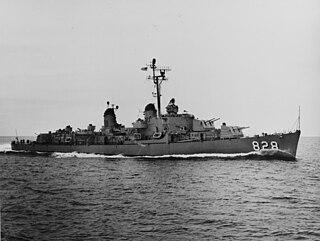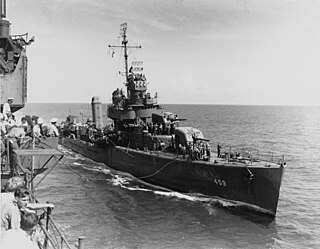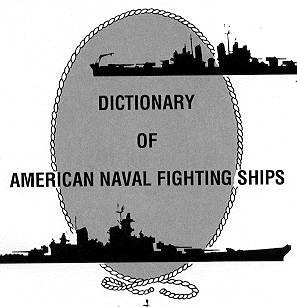
In naval terminology, a destroyer is a fast, maneuverable long-endurance warship intended to escort larger vessels in a fleet, convoy or battle group and defend them against smaller powerful short-range attackers. They were originally developed in the late 19th century by Fernando Villaamil for the Spanish Navy as a defense against torpedo boats, and by the time of the Russo-Japanese War in 1904, these "torpedo boat destroyers" (TBDs) were "large, swift, and powerfully armed torpedo boats designed to destroy other torpedo boats". Although the term "destroyer" had been used interchangeably with "TBD" and "torpedo boat destroyer" by navies since 1892, the term "torpedo boat destroyer" had been generally shortened to simply "destroyer" by nearly all navies by the First World War.

The Boston Navy Yard, originally called the Charlestown Navy Yard and later Boston Naval Shipyard, was one of the oldest shipbuilding facilities in the United States Navy. It was established in 1801 as part of the recent establishment of the new U.S. Department of the Navy in 1798. After 175 years of military service, it was decommissioned as a naval installation on 1 July 1974.

Bath Iron Works (BIW) is a major United States shipyard located on the Kennebec River in Bath, Maine, founded in 1884 as Bath Iron Works, Limited. BIW has built private, commercial, and military vessels, most of which have been ordered by the United States Navy. The shipyard has built and sometimes designed battleships, frigates, cruisers, and destroyers, including the Arleigh Burke class which are currently among the world's most advanced surface warships.

A guided-missile destroyer is a destroyer designed to launch guided missiles. Many are also equipped to carry out anti-submarine, anti-air, and anti-surface operations. The NATO standard designation for these vessels is DDG. Nations vary in their use of destroyer D designation in their hull pennant numbering, either prefixing or dropping it altogether. The U.S. Navy has adopted the classification DDG in the American hull classification system.

USS Cone (DD-866) was a Gearing-class destroyer of the United States Navy, named for Rear Admiral Hutch Ingham Cone USN (1871–1941). She was laid down by the Bethlehem Steel Corporation at Staten Island, New York, on 30 November 1944, launched on 10 May 1945 by Mrs. H. I. Cone, and commissioned on 18 August 1945.
A destroyer squadron is a naval squadron or flotilla usually consisting of destroyers rather than other types of vessel. In some navies other vessels, such as frigates, may be included. In English the word "squadron" tends to be used for larger and "flotilla" for smaller vessels; both may be used for destroyer units. Similar formations are used in non-English-speaking countries, e.g., the "escadrille"—which would translate directly as "squadron"—in France.
USS Cushing may refer to one of several United States Navy ships named in honor of William B. Cushing:

The Benson class was a class of destroyers of the U.S. Navy built 1939–1943. The thirty 1,620-ton Benson-class destroyers were built in two groups. The first six were authorized in fiscal year 1938 (FY38) and laid down at Bethlehem Steel, Quincy, Massachusetts and three naval shipyards. The remaining 24 “repeat Bensons” were authorized in 1940–42 and built at four Bethlehem Steel yards. They were laid down after the first group was commissioned. These plus the “repeat Livermores” were also known at the time as the Bristol class. During World War II the Bensons were usually combined with the Livermores as the Benson-Livermore class; this persisted in references until at least the 1960s. In some references both classes are combined and called the Benson class. The Benson- and Gleaves-class destroyers were the backbone of the pre-war Neutrality Patrols and brought the action to the enemy by participating in every major campaign of the war.

The Gleaves-class destroyers were a class of 66 destroyers of the United States Navy built 1938–42, designed by Gibbs & Cox. The first ship of the class was USS Gleaves. They were the production destroyer of the US Navy when it entered World War II.

USS Corry (DD-334) was a United States Navy Clemson-class destroyer launched and commissioned in 1921.
Bartlett Laffey was an Irish-born United States Navy sailor and Medal of Honor recipient.

The Federal Shipbuilding and Drydock Company was a United States shipyard, active from 1917 to 1948. It was founded during World War I to build ships for the United States Shipping Board. During World War II, it built ships as part of the U.S. Government's Emergency Shipbuilding program. Operated by a subsidiary of the United States Steel Corporation, the shipyard was located at Kearny Point where the mouth of the Hackensack River meets Newark Bay in the Port of New York and New Jersey. The shipyard site is now part of River Terminal, a massive distribution facility that is partially a foreign trade zone.

USS Percival (DD-452) redirects here.
Lieutenant Commander William Edwin Hank was an officer in the United States Navy during World War II.
Commander, Naval Surface Force, Atlantic (COMNAVSURFLANT) is a post within the United States Fleet Forces Command. As Naval Surface Force Atlantic, it is a military formation, but the organization is often known as SURFLANT. Its headquarters are at the Naval Station Norfolk, Norfolk, Virginia. The current commander is Rear Admiral Jesse Wilson. COMNAVSURFLANT supervises all surface ships based on the Eastern United States and Gulf Coast of the United States, as well as ships forwarded deployed to Naval Station Rota, Spain.

This list catalogs the most honored US ships of the Second World War. It is placed in descending order of earned Battle Stars; descending accorded unit recognitions; descending ship size by type; and ascending hull number. It contains only vessels that earned fifteen or more Battle Stars for World War II service. Honors awarded that are not listed may include:
Milton L. Knudson (1923–1942) was a United States Navy sailor who received the Navy and Marine Corps Medal posthumously for his actions during World War II.
Rear Admiral Frederick Julian Becton was a decorated United States Navy officer. He is probably best remembered for commanding the destroyer USS Laffey (DD-724) in World War II during an intense Japanese kamikaze attack.













